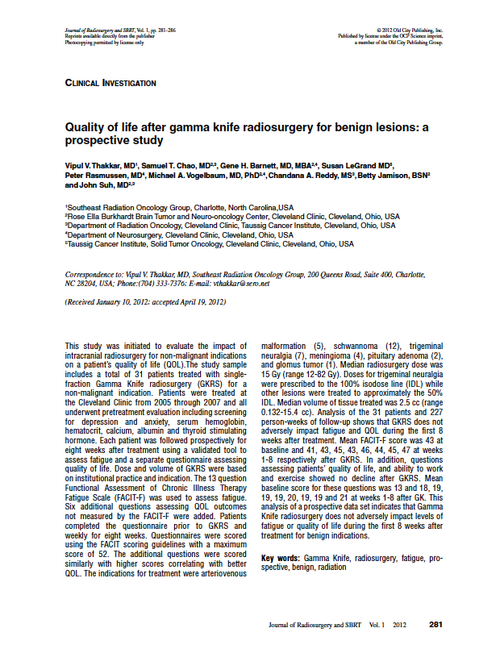- Home
- Journal Contents Downloads
- JRSBRT Downloads
- JRSBRT 1.4, p. 281-286
Product Description
Quality of life after gamma knife radiosurgery for benign lesions: a prospective study
Vipul V. Thakkar, Samuel T. Chao, Gene H. Barnett, Susan LeGrand, Peter Rasmussen, Michael A. Vogelbaum, Chandana A. Reddy, Betty Jamison, and John Suh
This study was initiated to evaluate the impact of intracranial radiosurgery for non-malignant indications on a patient’s quality of life (QOL). The study sample includes a total of 31 patients treated with single fraction Gamma Knife radiosurgery (GKRS) for a non-malignant indication. Patients were treated at the Cleveland Clinic from 2005 through 2007 and all underwent pretreatment evaluation including screening for depression and anxiety, serum hemoglobin, hematocrit, calcium, albumin and thyroid stimulating hormone. Each patient was followed prospectively for eight weeks after treatment using a validated tool to assess fatigue and a separate questionnaire assessing quality of life. Dose and volume of GKRS were based on institutional practice and indication. The 13 question Functional Assessment of Chronic Illness Therapy Fatigue Scale (FACIT-F) was used to assess fatigue. Six additional questions assessing QOL outcomes not measured by the FACIT-F were added. Patients completed the questionnaire prior to GKRS and weekly for eight weeks. Questionnaires were scored using the FACIT scoring guidelines with a maximum score of 52. The additional questions were scored similarly with higher scores correlating with better QOL. The indications for treatment were arteriovenous malformation (5), schwannoma (12), trigeminal neuralgia (7), meningioma (4), pituitary adenoma (2), and glomus tumor (1). Median radiosurgery dose was 15 Gy (range 12-82 Gy). Doses for trigeminal neuralgia were prescribed to the 100% isodose line (IDL) while other lesions were treated to approximately the 50% IDL. Median volume of tissue treated was 2.5 cc (range 0.132-15.4 cc). Analysis of the 31 patients and 227 person-weeks of follow-up shows that GKRS does not adversely impact fatigue and QOL during the first 8 weeks after treatment. Mean FACIT-F score was 43 at baseline and 41, 43, 45, 43, 46, 44, 45, 47 at weeks 1-8 respectively after GKRS. In addition, questions assessing patients’ quality of life, and ability to work and exercise showed no decline after GKRS. Mean baseline score for these questions was 13 and 18, 19, 19, 19, 20, 19, 19 and 21 at weeks 1-8 after GK. This analysis of a prospective data set indicates that Gamma Knife radiosurgery does not adversely impact levels of fatigue or quality of life during the first 8 weeks after treatment for benign indications.
Keywords: Gamma Knife, radiosurgery, fatigue, prospective, benign, radiation
After payment has been processed for your order of a digital copy (PDF) of this article, you will see a download link on your completed order page and also receive an email containing a download link. The links, which will enable you to download one copy of the article, will expire after 24 hours.
 Loading... Please wait...
Loading... Please wait...



